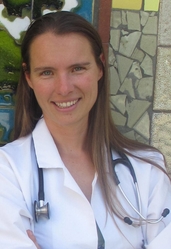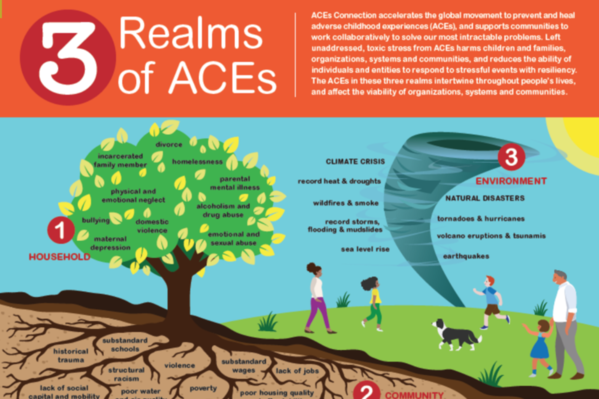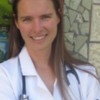Ed. note: This is one of a series of stories we're doing about ACEs science champions around the world. To read the others, go to ACEs Science Champions.
Dr. Angela Bymaster, a family physician at Washington Elementary School in San Jose, CA, operates her clinic in a portable unit on the school property. The clinic is funded by the nonprofit School Health Clinics of Santa Clara County.
Because the unit faces students as they are dropped off by their families, she gets to “pick up the kids” before they are sent to the clinic, practicing “upstream medicine.” She herself has five kids: three of whom she and her husband adopted from South Sudan and who are now adults; one is a 16-year-old Mexican American girl who is her goddaughter; and a son to whom she gave birth nine years ago.
 Her nine-year-old son is the only blue-eyed child at Washington Elementary, which serves low-income, Latino children. Families crowd into homes in the Washington-Guadalupe neighborhood, located at the crossroads of two highways. Everyone at Washington Elementary is “English learning,” she says.
Her nine-year-old son is the only blue-eyed child at Washington Elementary, which serves low-income, Latino children. Families crowd into homes in the Washington-Guadalupe neighborhood, located at the crossroads of two highways. Everyone at Washington Elementary is “English learning,” she says.
Bymaster can’t recall how she learned about the science of adverse childhood experiences (ACEs science), but when she did hear about it she remembers thinking: “It was immediately obviously true.”
The term "adverse childhood experiences" — ACEs — comes from a landmark study that shows how widespread childhood adversity is. The CDC-Kaiser Permanente Adverse Childhood Experience Study of more than 17,000 mostly white, middle-class adults, was first published in 1998. It linked 10 types of childhood adversity — such as living with a parent who is mentally ill, has abused alcohol or is emotionally abusive — to the adult onset of chronic disease, mental illness, violence and being a victim of violence. Many other types of ACEs— including racism, bullying, a father being abused, and community violence — have been added to subsequent ACE surveys.

The study, whose first of more than 70 publications came out in 1998, emerged with a growing body of ACEs science that includes: how toxic stress from ACEs damages children’s brains; the epigenetic consequences of ACEs that shows how toxic stress can be passed on from one generation to the next; how toxic stress from ACEs results in short- and long-term health consequences; and how appropriate supports can build resilience and heal the harmful effects of toxic stress from ACEs. (ACEs Science 101.)
Bymaster grew up in a small town in Oregon and after college, took a gap year doing a program called Mission Year, a faith-based program to strengthen community and support justice nationwide. That’s how she met her husband, an electrical engineer-turned-pastor who is engaged in helping youth.
After earning a degree at a small Quaker college in Oregon and doing a year of medical school at the University of Iowa, she took a year off to live as a “housewife” in West Oakland with her husband, who is also “super aware of ACEs science” from his work in Mission Year and also from living in low-income urban areas. “My husband and I are Christians and have always chosen in to live in low-income neighborhoods,” she explains.
Bymaster says that “so many kids, many who were so obviously neglected, came over,” to their place in West Oakland. “One kid — he was nine — came every single day. We would take him home at night and his family wouldn’t even open the door for him.
“He was pretty violent at time, torturing animals, starting fires in the school. He was working on his behavior because I told him I’d kick him out of our place if he didn’t behave. He stayed longer and longer every day and I got to learn from him how much trauma he had experienced.”
That boy died in his 20s due to violence. “So many times ACEs cut short people’s lives,” she says. (Here's an article about the research Bymaster did about the link between ACEs and homelessness.)
Although Bymaster is not screening her patients for ACEs now, she has interviewed many of her patients about their childhood adversity. She refers high-ACE students to a class she created, Arte de Vida, or Art of Life, where teens and their parents meet once a week over five weeks to talk about their stories and cultural differences and then do an art project, whether in clay or paint, that expresses these topics. She sought small grants for this program and used them to hire an artist to bring in materials for the students.
The first two weeks of Arte de Vida are about ACEs science. Participants self-screen using a survey that includes the 10 questions, including those about abuse, violence, and neglect. For elementary children, she created a picture-based version.
The other three weeks of Arte de Vida cover cultural values and then participants do an art project related to what was discussed. Angela says the program started conversations: Parents talked about their childhood, and empathy was built between them and their teens. Here's an article with more details about the course.
Based on her experience with ACEs science, including resilience, Bymaster is launching a new clinic this summer with Dr. Cheryl Ho, a nationally recognized internist who founded the county’s homeless program, as well as with a Spanish-speaking pastor. The clinic will be built on ACEs science and “how we can promote true healing” because so far, she points out, there has been little done to promote long-term healing. They are applying for a grant, pitching churches and individual donors, and offering people a membership for concierge-quality primary care. Each member will also fund two low-income people.
Churches are a resource, says Bymaster, because many churches already employ various healing curricula for those experiencing ACEs. In addition, the vast majority of low-income Latinos are people of faith and are used to the language of faith.
The new clinic, based in San Jose, will screen for ACEs and then take some novel therapeutic approaches, including building a volleyball team, and offering classes for journaling and cooking. For a look at what she and Ho are planning, check out this site: www.Healinggrove.org.
And we’ll check out the clinic in the future to report on the progress this faith-based ACEs family physician has made.



Comments (2)